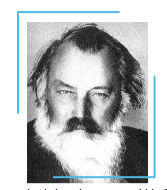 Composed 1890; 29 minutes
Composed 1890; 29 minutes
Brahms, ever mindful of musical history, knew that Beethoven’s Op. 111 was his final piano sonata, a landmark farewell to the genre. When Brahms reached his own Op. 111, he seriously considered making it his swansong. In December 1890, at 57, he sent the completed manuscript of today’s G major String Quintet to his publisher, enclosing a letter: “With this letter, you can bid farewell to my music,” he wrote, “because it is certainly time to leave off.”
His words reflect a late 19th century sense of finality. The world around him was changing. Satie had already composed his Gymnopédies, and Debussy was soon to begin his revolutionary Prélude à l’Après-midi d’un Faune. The Eiffel Tower, Brooklyn Bridge, and Statue of Liberty were marvels of modern engineering. In Chicago, the Manhattan Building had risen to 16 stories, the tallest in the world. Brahms, deeply aware of his place in musical history, saw himself as an heir to Bach, Mozart, and Beethoven, yet his magisterial G major String Quintet, Op. 111, is no relic of the past. Its architectural clarity honors tradition, while its melodic and textural sophistication reaches toward the 20th century.
From the opening bars, the quintet’s texture is rich and full. The first movement begins with the cello introducing the main theme over a powerful tremolando from the upper strings. Scholars believe this theme originated in sketches for a Fifth Symphony. Certainly, its symphonic breadth and resonance suggest as much. The movement’s passion and exuberance remain undimmed throughout. When his friend and biographer Max Kalbeck remarked that it evoked the Prater—the great Viennese park where Brahms often strolled—the composer quipped: “You’ve guessed it! And all the pretty girls, too.”
Brahms had a deep affinity for the viola and its alto register. By adding a second viola to the traditional string quartet, he followed a lineage reaching back to Mozart, who had composed the last major works for this combination. The Adagio unfolds as a deeply resonant set of variations on an elegiac theme first heard in the viola. The third movement carries the gently wistful nostalgia Brahms explored in his late piano works. The finale bursts with exuberance, infused with the Hungarian fire that animates many of his closing movements. It stands as the last and one of the finest of his folk-inspired finales.
— All program notes copyright © 2025 Keith Horner.
Comments welcomed: khnotes@sympatico.ca
